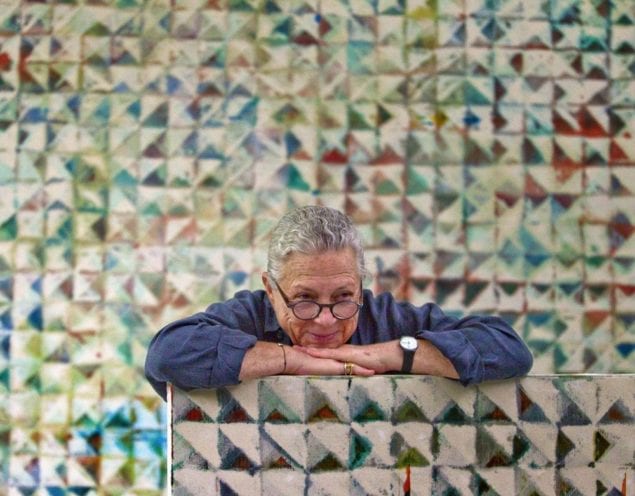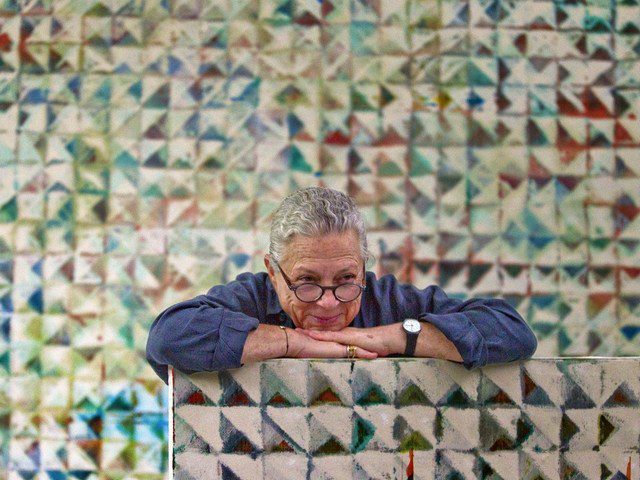
(Photo courtesy of Gelfman Studio)
Pérez Art Museum Miami (PAMM) has announced plans to present “Grids: A Selection of Paintings by Lynne Golob Gelfman,” a collection of approximately 25 paintings by Miami-based artist Lynne Golob Gelfman.
The most comprehensive show by Gelfman to date, the exhibition will showcase paintings the artist has produced during the past two decades, as well as examples of early works from the late 1960s and early ’70s — the majority of which have never been seen publicly before. Interested in exploring various forms of mark-making and patterning techniques, Gelfman produces in series, using oil, acrylic and flash paint on both canvas and wood. Examples from five of her series will be on view as part of the exhibition from Sept. 15 to Apr. 21, 2019.
One of Miami’s most esteemed abstract artists, Gelfman utilizes methods that play with surfaces in diverse ways, with certain series involving staining into the canvas, others creating reflections in gold and silver, and still others channeling drips of paint in angular lines down the front of her paintings.
A self-described trickster, Gelfman is trained in traditional modernist aesthetics, which she honors in her work but consistently subverts with the intention to disobey rules and conventions. The most visible example of this is her decision to paint the backs of her canvases. This allows the established grid pattern she creates to become disrupted— distorted — as the paint bleeds through fabric and appears on the front of the canvas.
Gelfman credits her move to Miami in 1972 as the motivation for this technique. Longing for New York City, she came to the realization that the dark, urban settings of her previous paintings felt out of place in the tropical light of Miami. Following a fortuitous accident upon which she looked at the back of a grid painting and observed a resulting “bleached-out light” effect — an effect much more in line with her new Miami surroundings — Gelfman began consciously turning the back to the front.
Since then, Miami’s unique environment has continually influenced Gelfman’s work: the patterns and details of its tropical flora and fauna, the textures of the sea and bleaching effects of sunlight, and in several series elements taken from its urban infrastructure and architecture.
For example, her oil and sand series references the curling, linear metal work used in many working-class neighborhoods in Miami to secure windows and gates. Meanwhile, her between paintings transform the grid of chain-link fences, often used to aggressively divide urban spaces into shimmering, transparent patterns that recall the movement of sunlight on the sea.
Gelfman’s work also is reflective of her time spent in Colombia, where she has lived and worked periodically throughout her career, and during where she has investigated indigenous textile and basket weaving techniques. Series that evidence these influences include lines, where invisible horizontal markings interact with applications of dripping paint that move vertically down the surface, creating a patterning that recalls the irregular grids of textiles. The thru series additionally recalls weaving patterns, through its use of repeating triangle and square forms. She began this series in the 1970s but has returned to it in recent years, producing works at varying scales and formats.
Gelfman’s alterations of the grid show this geometric and rational form as quite vulnerable, as easily susceptible to dissolution and manipulation. The artist has described this aspect of her work as referencing the rapid disintegrations and manipulations of values and ethics within our contemporary society.
A Miami resident since 1972, Gelfman has had more than 40 solo shows. Her first solo show was a prize awarded by Miami’s Metropolitan Museum and Art Center in 1974, then under the leadership of Arnold Lehman. Since then, Gelfman has exhibited nationally and internationally in galleries and museums. Her work also is a part of many public and private collections, including Pérez Art Museum Miami. For the past 15 years, she has developed art projects with inner-city children at the Barnyard in Coconut Grove.
For more information, visit www.pamm.org.






